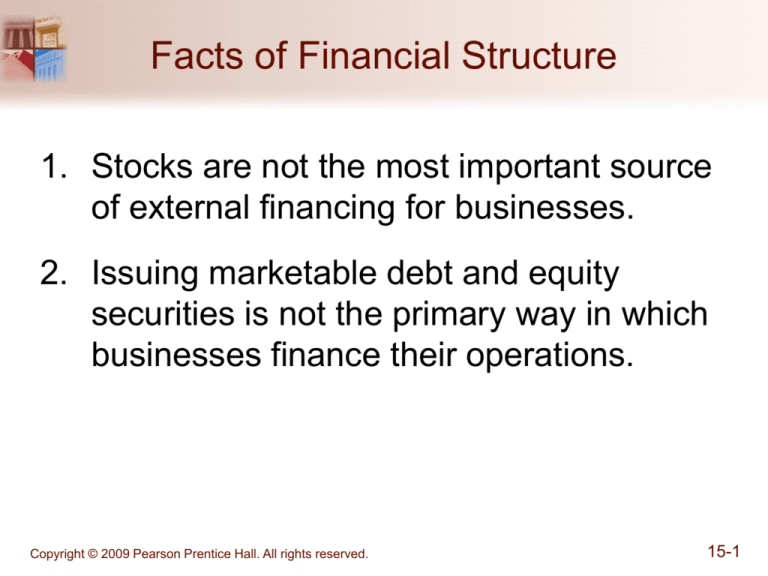
Facts of Financial Structure
1. Stocks are not the most important source
of external financing for businesses.
2. Issuing marketable debt and equity
securities is not the primary way in which
businesses finance their operations.
Copyright © 2009 Pearson Prentice Hall. All rights reserved.
15-1
Facts of Financial Structure
3. Indirect finance, which involves the activities of
financial intermediaries, is many times more
important than direct finance.
4. Financial intermediaries, particularly banks, are
the most important source of external funds
used to finance businesses. Only large, wellestablished corporations have easy access to
securities markets to finance their activities
Copyright © 2009 Pearson Prentice Hall. All rights reserved.
15-2
Facts of Financial Structure
5. Collateral is a prevalent feature of debt
contracts for both households
and businesses.
6. Debt contracts are typically extremely
complicated legal documents that place
substantial restrictions on the behavior of
the borrowers: restrictive covenants.
Copyright © 2009 Pearson Prentice Hall. All rights reserved.
15-3
Collateral
• Debt is subject to adverse selection.
• Collateral reduces the consequences of
adverse selection because it reduces the
lender’s losses in the event of a default.
• If a borrower defaults on a loan, the lender
can sell the collateral and use the proceeds
to make up for the losses on the loan.
Copyright © 2009 Pearson Prentice Hall. All rights reserved.
15-4
Collateral
• Collateral is property that is pledged to a
lender to guarantee payment in the event
that the borrower is unable to make debt
payments
• Collateralized debt or secured debt
• Ex: your house is collateral for your
mortgage
Copyright © 2009 Pearson Prentice Hall. All rights reserved.
15-5
Collateral
• Debt is subject to moral hazard.
• In fact, debt may create an incentive to take
on very risky projects. This is important to
understand. Let’s looks at a simple
example.
Copyright © 2009 Pearson Prentice Hall. All rights reserved.
15-6
Collateral
• Most debt contracts require the borrower to pay a
fixed amount (interest) and keep any cash flow
above this amount.
• For example, what if a firm owes $100 in interest,
but only has $90? It is essentially bankrupt. The
firm “has nothing to lose” by looking for “risky”
projects to raise the needed cash.
Copyright © 2009 Pearson Prentice Hall. All rights reserved.
15-7
Collateral
• When the collateral pledged to a lender is
valuable, the risk of moral hazard will be
greatly reduced because the borrowers
themselves have a lot to lose.
Copyright © 2009 Pearson Prentice Hall. All rights reserved.
15-8
How Moral Hazard Influences Financial
Structure in Debt Markets
•
Other Tools to Help Solve Moral Hazard in
Debt Contracts
1. Net Worth
2. Monitoring and Enforcement of
Restrictive Covenants. Examples are covenants
that …
1. discourage undesirable behavior
2. encourage desirable behavior
3. keep collateral valuable
4. provide information
Copyright © 2009 Pearson Prentice Hall. All rights reserved.
15-9
Restrictive covenants
• Covenants to discourage undesirable
behavior
• Some covenants mandate that a loan can
be used only to finance specific activities,
such as the purchase of particular
equipment or inventories.
Copyright © 2009 Pearson Prentice Hall. All rights reserved.
15-10
Restrictive covenants
• Covenants to encourage desirable behavior
• They encourage the borrower to engage in
desirable activities that make it more likely
that the loan will be paid off
• Life insurance that pays off the mortgage
upon the borrower’s death
Copyright © 2009 Pearson Prentice Hall. All rights reserved.
15-11
Restrictive covenants
• Covenants to keep collateral valuable
• Restrictive covenants can encourage the
borrower to keep the collateral in good
condition and make sure that it stays in the
possession of the borrower
• Insurance on the home
Copyright © 2009 Pearson Prentice Hall. All rights reserved.
15-12
Restrictive covenants
• Covenants to provide information
• Restrictive covenants can require a
borrower to provide information about its
activities periodically
• Balance sheet, income reports
Copyright © 2009 Pearson Prentice Hall. All rights reserved.
15-13






